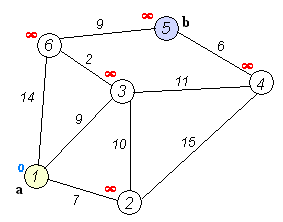This is a common graph theory problem algorithm
In graph theory, the shortest path problem is the problem of finding a
path between two vertices (or nodes) in a graph such that the sum of
the weights of its constituent edges is minimized.The problem of finding the shortest path between two intersections on
a road map (the graph’s vertices correspond to intersections and the
edges correspond to road segments, each weighted by the length of its
road segment) may be modeled by a special case of the shortest path
problem in graphs.
For now exists lot of implementations of this algorithm. More simpler in implementation is a Dijkstra’s algorithm with worst case performance as O(|E|+|V|log|V|) where
- |V| is the number of nodes
- |E| is the number of edges
Illustration of algorithm work
Definition of Dijkstra’s Shortest Path Algorithm
- initial node – the node at which we are starting.
- distance of node Y – be the distance from the initial node to Y.
Algorithm will assign some initial distance values and will try to improve them step by step:
-
Assign to every node a tentative distance value: set it to 0 for our initial node and to ∞ for all other nodes.
-
Set the initial node as current. Mark all other nodes unvisited. Create a set of all the unvisited nodes called the unvisited set.
-
For the current node, consider all of its unvisited neighbors and calculate their tentative distances. Compare the newly calculated tentative distance to the current assigned value and assign the smaller one.
-
When we are done considering all of the neighbors of the current node, mark the current node as visited and remove it from the unvisited set. A visited node will never be checked again.
-
If the destination node has been marked visited (when planning a route between two specific nodes) or if the smallest tentative distance among the nodes in the unvisited set is ∞ (when planning a complete traversal; occurs when there is no connection between the initial node and remaining unvisited nodes), then stop. The algorithm has finished.
-
Otherwise, select the unvisited node that is marked with the smallest tentative distance, set it as the new “current node”, and go back to step 3.
More implementations of Dijkstra algorithm you can find on github repository mburst/dijkstras-algorithm.
For example here is JavaScript implementation
